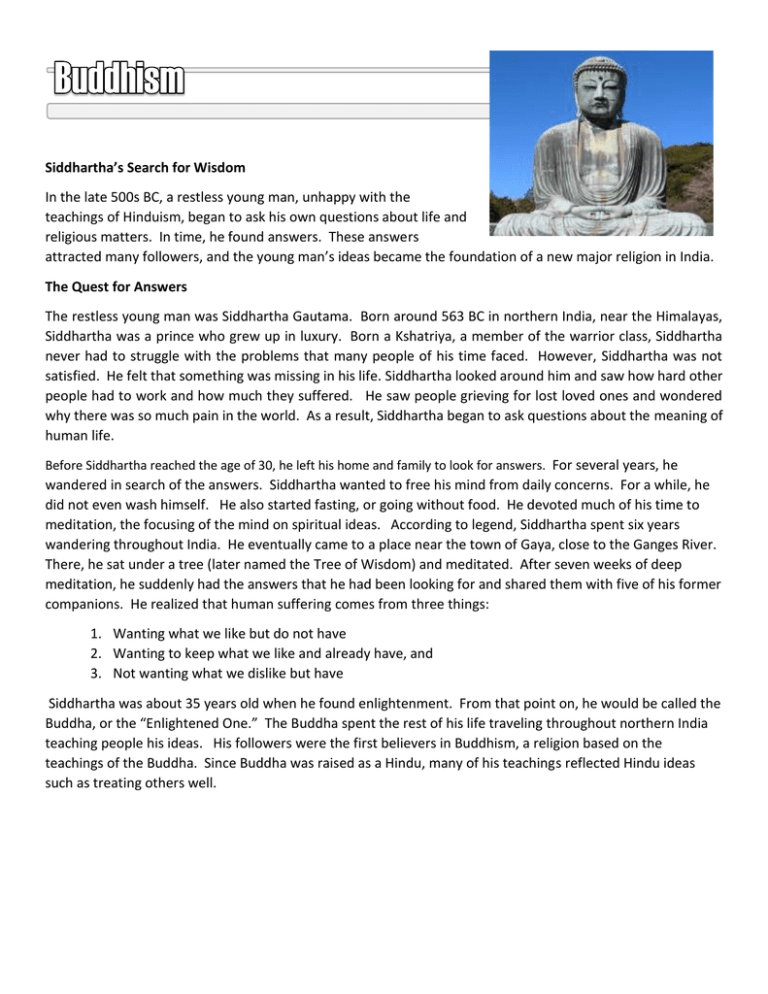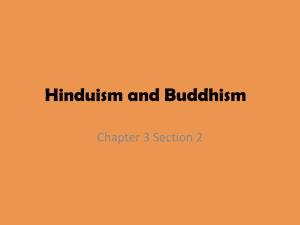Buddhism
advertisement

Siddhartha’s Search for Wisdom In the late 500s BC, a restless young man, unhappy with the teachings of Hinduism, began to ask his own questions about life and religious matters. In time, he found answers. These answers attracted many followers, and the young man’s ideas became the foundation of a new major religion in India. The Quest for Answers The restless young man was Siddhartha Gautama. Born around 563 BC in northern India, near the Himalayas, Siddhartha was a prince who grew up in luxury. Born a Kshatriya, a member of the warrior class, Siddhartha never had to struggle with the problems that many people of his time faced. However, Siddhartha was not satisfied. He felt that something was missing in his life. Siddhartha looked around him and saw how hard other people had to work and how much they suffered. He saw people grieving for lost loved ones and wondered why there was so much pain in the world. As a result, Siddhartha began to ask questions about the meaning of human life. Before Siddhartha reached the age of 30, he left his home and family to look for answers. For several years, he wandered in search of the answers. Siddhartha wanted to free his mind from daily concerns. For a while, he did not even wash himself. He also started fasting, or going without food. He devoted much of his time to meditation, the focusing of the mind on spiritual ideas. According to legend, Siddhartha spent six years wandering throughout India. He eventually came to a place near the town of Gaya, close to the Ganges River. There, he sat under a tree (later named the Tree of Wisdom) and meditated. After seven weeks of deep meditation, he suddenly had the answers that he had been looking for and shared them with five of his former companions. He realized that human suffering comes from three things: 1. Wanting what we like but do not have 2. Wanting to keep what we like and already have, and 3. Not wanting what we dislike but have Siddhartha was about 35 years old when he found enlightenment. From that point on, he would be called the Buddha, or the “Enlightened One.” The Buddha spent the rest of his life traveling throughout northern India teaching people his ideas. His followers were the first believers in Buddhism, a religion based on the teachings of the Buddha. Since Buddha was raised as a Hindu, many of his teachings reflected Hindu ideas such as treating others well. Four Noble Truths At the heart of Buddha’s teachings were four guiding principles. These became known as the Four Noble Truths: 1. Suffering and unhappiness are part of human life. No one can escape sorrow. 2. Suffering comes from our desires for pleasure and material goods. People cause their own misery because they want things they cannot have. 3. People can overcome desire and ignorance and reach nirvana (a state of perfect peace). Reaching nirvana frees the soul from suffering and from the need for further reincarnation. 4. People can overcome ignorance and desire by following an eightfold path that leads to wisdom, enlightenment and salvation. The Eightfold Path includes Right Thought, Right Intent, Right Speech, Right Action, Right Livelihood, Right Effort, Right Mindfulness, and Right Concentration. Challenging Hindu Ideas Some of the Buddha’s teaching challenged traditional Hindu ideas. For example, the Buddha rejected many of the ideas contained in the Vedas, such as animal sacrifice. He told the people that they did not have to follow these texts. The Buddha challenged the authority of the Hindu priests, the Brahmins. He did not believe that they, or their rituals, were necessary for enlightenment. Instead, he taught that it was the responsibility of each individual to work for his or her own salvation. Priests could not help them. However the Buddha did not reject the Hindu teachings of reincarnation. He taught that people who failed to reach nirvana would have to be reborn time and time again until they achieved it. The Buddha was opposed to the caste system. He did not think that people should be confined to a particular place in society. Everyone who followed the Eight-fold Path properly, he said, would achieve nirvana. It didn’t matter what varna or caste they had belonged to in life as long as they lived the way they should. The Buddha’s opposition to the caste system won him support from the masses. Many of India’s herdsmen, farmers, artisans, and untouchables liked hearing that their low social rank would not be a barrier to enlightenment. Unlike Hinduism, Buddhism made them feel that they had the power to change their lives. The Buddha also gained followers among the higher classes. Many rich and powerful Indians welcomed his ideas about avoiding extreme behavior while seeking salvation. By the time of his death around 483BC, the Buddha’s influence was spreading rapidly. His ideas were popular and easy to understand, and within 200 years, the teachings had spread throughout most of India. One of India’s most powerful kings, Asoka, became a Buddhist in the 200s BC and sent missionaries to Sri Lanka, the Himalayas, and Southeast Asia. Eventually Buddhism spread via the Silk Road into China, Korea, and Japan.








